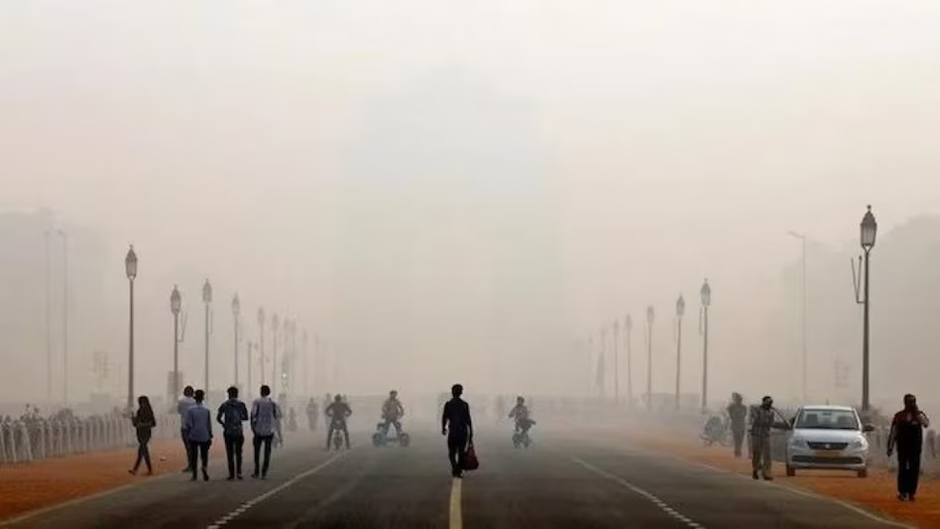- Courses
- GS Full Course 1 Year
- GS Full Course 2 Year
- GS Full Course 3 Year
- GS Full Course Till Selection
- MEP (Mains Enrichment Programme) Data, Facts
- Essay Target – 150+ Marks
- Online Program
- GS Recorded Course
- NCERT- First Ladder
- Polity
- Geography
- Economy
- Ancient, Medieval and Art & Culture AMAC
- Modern India, Post Independence & World History
- Environment
- Governance
- Science & Technology
- International Relations and Internal Security
- Disaster Management
- Ethics
- Current Affairs
- Indian Society and Social Issue
- CSAT
- 5 LAYERED ARJUNA Mentorship
- Public Administration Optional
- ABOUT US
- OUR TOPPERS
- TEST SERIES
- FREE STUDY MATERIAL
- VIDEOS
- CONTACT US
Delhi’s Winter 21-point winter action plan to Curb Air Pollution
Delhi’s Winter 21-point winter action plan to Curb Air Pollution

The Delhi government has unveiled a comprehensive 21-point winter action plan aimed at addressing the severe air pollution typically seen in the city during the winter months. This plan includes innovative measures such as real-time drone surveys and the formation of a special task force.
What Does Delhi's Winter Action Plan Include?
-
Real-Time Drone Surveys: Drones will be used for the first time to monitor pollution hotspots in real-time, providing up-to-date data to enhance pollution control measures.
-
Special Task Force: A dedicated task force will oversee the implementation of the action plan, ensuring its effective execution and coordination among various agencies.
Key Focus Areas:
-
Pollution Hotspots: The plan prioritizes areas with the highest pollution levels, targeting vehicular and dust pollution.
-
Work-from-Home Policy: Encouraging private organizations to adopt remote work to reduce vehicular emissions.
-
Stubble and Garbage Burning: Addressing the issue of stubble burning and garbage disposal to curb emissions.
-
Regulation of Industrial Emissions: Implementing stricter controls on industrial pollution.
-
Emergency Measures: Includes options like odd-even vehicle rationing, artificial rain to manage pollution, and awarding Harit Ratna (a green award) to environmentally friendly organizations.
|
Artificial Rain Artificial rain is produced through a process called cloud seeding, which involves dispersing certain substances into the clouds to induce rainfall. Substances Commonly Used in Artificial Rain:
Applications of Artificial Rain: Drought relief, Agricultural support, Air pollution reduction (e.g., in cities like Beijing or Delhi) and Forest fire control |
Key Stakeholders:
The Environment Department, Delhi Pollution Control Committee (DPCC), Municipal Corporation of Delhi (MCD), Delhi Traffic Police, Delhi Development Authority (DDA), and Delhi State Industrial and Infrastructure Development Corporation (DSIIDC) will collaborate to monitor and implement the plan.
What are the Main Causes of Air Pollution in Delhi During Winters?
-
Stubble Burning: Farmers in Punjab and Haryana burn crop residues, which contributes significantly to air pollution in Delhi. This practice releases large amounts of smoke and particulate matter (PM).
-
According to SAFAR, stubble burning significantly affects Delhi’s air quality, emitting harmful gases such as Carbon Monoxide (CO), methane (CH4), and VOCs.
-
-
Vehicle Emissions: Vehicular emissions are a major source of pollution, contributing to 28% of PM2.5 emissions in Delhi.
-
High levels of ground-level ozone (O3) are also observed in traffic hotspots, leading to health concerns.
-
-
Wind Direction: Predominant northwesterly winds during winter bring dust and smoke from stubble burning areas to Delhi.
-
Studies show that 72% of Delhi’s winter winds come from northwestern regions, influencing pollution levels in the city.
-
-
Dry and Still Air: Winter’s reduced rainfall and lower wind speeds lead to accumulation of PM and worsened air quality as pollutants remain suspended in the air.
-
Temperature Inversion: Inversion layers trap pollutants near the ground, worsening smog and air quality. This phenomenon is more common in winter when the weather is calm and cold.
-
Other Sources: Additional winter pollution sources include dust storms, firecrackers, and domestic biomass burning. Biomass burning contributes 17-26% of particulate matter in winter.
What are the Indian Government Initiatives Related to Air Pollution?
-
Graded Response Action Plan (Delhi): A framework for responding to various levels of air pollution severity in Delhi.
-
System of Air Quality and Weather Forecasting and Research (SAFAR) Portal: Provides real-time air quality data and forecasts.
-
Air Quality Index (AQI): A system for reporting daily air quality and its impact on health.
-
Turbo Happy Seeder (THS) Machine: A tool designed to reduce stubble burning by allowing farmers to sow crops without removing residues.
-
National Air Quality Monitoring Programme (NAMP): Monitors air quality across the country.
-
Polluter Pay Principle: Encourages polluters to bear the costs of pollution.
-
Reducing Vehicular Pollution: Implementation of BS-VI vehicle standards, promotion of electric vehicles (EVs), and emergency measures like the odd-even policy in Delhi.
Key Terms Related to Air Pollution:
-
Air Quality Index (AQI): Measures daily air quality and its potential health effects. AQI covers pollutants like ground-level ozone, PM10, PM2.5, CO, SO2, NO2, NH3, and Pb.
-
Volatile Organic Compounds (VOCs): Chemicals released from vehicles and other sources that impact air quality and health.
-
Ground-Level Ozone: Formed when NOx and VOCs react in sunlight, contributing to smog, especially during warmer months.
Way Forward
-
Strict Emission Control Policies: Enforce vehicular emission standards and promote EV adoption through initiatives like the Electric Mobility Promotion Scheme (EMPS) 2024.
-
Waste Management and Regulation: Implement strict regulations to reduce open waste burning and improve waste management practices. Adopt successful models from cities like Surat and Indore.
-
Crop Residue Management: Provide sustainable alternatives for residue management, such as Happy Seeder, and offer subsidies for crop residue management machines.
-
Implementation of Green Infrastructure: Develop green belts, parks, and afforestation projects to improve the city’s capacity to absorb pollutants.
Conclusion:
Delhi’s winter air pollution is a multifaceted challenge driven by various factors, including stubble burning, vehicular emissions, and meteorological conditions. The newly launched 21-point winter action plan represents a proactive and multifaceted approach to tackling these issues. By incorporating real-time monitoring with drones, enforcing stricter regulations, and preparing for emergency measures, the plan aims to significantly improve air quality. However, for long-term success, continuous efforts are needed beyond seasonal plans. Balancing economic development with environmental stewardship remains essential, as does fostering public awareness and involvement in pollution control efforts.




